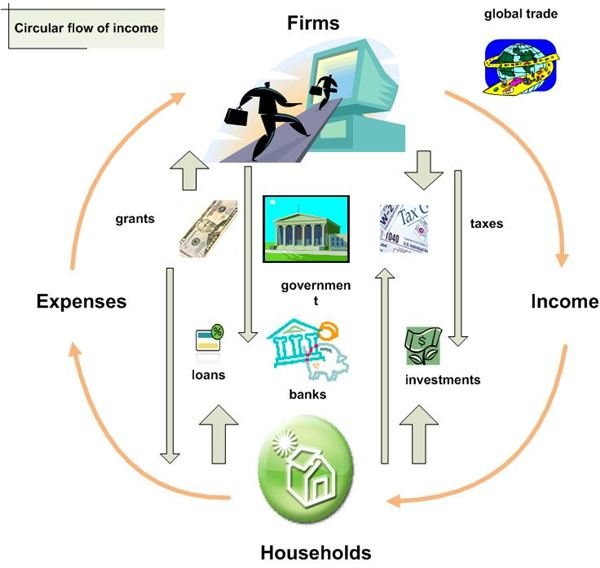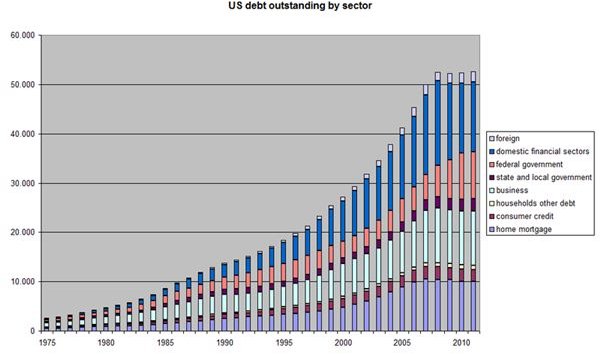Comprehending the Circular Flow of Income as an Economic Model
Understanding the Gross Domestic Product (GDP)
Let us delve into an economic model known as the “circular flow of income” to understand the factors that make an economy good or bad. We need to have a clear grasp of how money flows into a system and how it should be kept in circulation. Comprehend that money is the main factor that keeps every component of a basic unit working like a well-oiled machine.
News that makes reference to GDP, which stands for Gross Domestic Product, is a reference to the country’s growth rate in terms of goods and services produced as output. However, there is much complexity in determining the GDP concept used in macroeconomics as an indicator of a country’s economic growth. Part of such complexity is to make sure that the measure of all outputs (goods and services produced and rendered) are not counted twice.
By way of example, suppose a food firm produces hamburger buns for the entire year on a nationwide scale. Including the dollar value of the total buns produced by the firm would likely result in a double count, because some of those hamburger buns form part of the output of another firm such as a fast food chain.

Thus, economists make use of a diagram called the “circular flow of income” to avoid the double-counting dilemma as it works on the assumption that all outputs produced by firms were sold and that income earned by households were spent.
We will use the same approach as we study the chart on the left and understand that business organizations provide income by paying salaries to employees. The latter’s household in turn uses their pay checks for domestic expenses comprising goods and services. If the goods include the purchase of buns, the household members would have bought them either as a purchase from the retail (grocery) industry or from the fast food industry, or both.
Hence, the more accurate value to consider as the total dollar value of hamburger buns produced for consumption would be the amount spent by the household and not the total dollar value of the buns produced by the food firm. This eliminates the possibility of counting the dollar value of hamburger bun production twice; first as the output of the food firm and second as the output of the fast food industry.
Determining the growth rate doesn’t stop there since it’s only a measure of the GDP. There is still the matter of using GDP as the indicator of economic growth.
Approaches for Determining Economic Growth

There are three methods being used to determine the wealth of the economy. The idea is to comprehend how money should circulate within an economic entity and the increase or growth realized by both the business and household sectors after the end of each circulation cycle. The theory is that at any given standpoint, whether from the point of view of the business firm or from the household sector, or even from the product which circulated, the resulting income from selling the output will be consistent. The three methods/standpoints are:
- National Income
- National Output
- National Expenditure
However, one should perceive that there are other components comprising the economy such as the government and the banking and financing institutions. These factors encroach on money that leaks out of or into the circle and can affect the income of the business and household sectors. They are referred to as “leakages” as they spread out of the circular path. A leakage can be any of the following:
-
The taxes the government collects on income earned by businesses and employees; hence, there should be necessary adjustments pertaining to this item.
-
Additional funds infused by the government to the business in the form of grants or as a subsidy to the household.
-
The part of the household income that goes into savings or retirement investments, which therefore, should be added back.
-
There are also the loans or credit card purchases, availed by both household and business sectors; hence, part of the money used to defray expenses is derived from credit.
-
Since credit purchases have to be paid, it follows that repayments form part of the household expenses.
All these factors are considered in calculating the income derived from the output produced and rendered within the economic unit. The contention is that after all adjustments have been taken into consideration, the value of the income will be the same, regardless of which approach was used.
We will leave the method of calculating the GDP income to the economists since it is quite complex. Nonetheless, this discussion still aims to establish the answers that would satisfy questions about when and where economic problems happen, and the factors that caused the U.S. economy to turn bad.
Taking the Money Out of the Circle

Money matters get complicated once goods and services are paid to entities that are outside of the circle. This of course refers to foreign trade.
It is also expected that money will be derived from the same source because ideally, there should be reciprocity. Hence, goods from outside the circle are likewise allowed to come into the picture in order to maintain equilibrium between nations.
To facilitate global trading, which involves the exchange of exports and imports, the U.S. must maintain a current account with the International Monetary Fund World Bank. If exports or products sold by the U.S. to other countries exceed imports, or the goods bought by the U.S. for local consumption, then there will be a surplus. Naturally this would increase the current account deposit maintained at IMF.
The reality in all of these is that America, at present, holds the record for having the largest amount of current account deficit at –US $466, 513 billion. However, this figure already represents a significant reduction from the deficit balance posted in 2006 at –US $802, 637 billion. Other realities to ponder include:
-
The years of economic recessions from 2008-2010 saw the U.S. posting a negative growth rate in industrial production.
-
Accordingly, the U.S. has the largest amounts of investment both locally ($2.398 trillion as of 2010) and globally ($3.259 trillion abroad as of 2010).
-
Unlike their European and Asian counterparts, U.S. business firms are finding it difficult to hurdle the entry barriers as their means to compete in the global markets.
-
The U.S. service industry comprising information technology, transportation and warehousing, scientific, professional and technical services, educational services, food services and accommodation, wholesale trade, and healthcare trade, just to mention a few, makes-up 72 percent of the GDP.
-
The most recent development is the downgrading of U.S. credit rating from AAA to AA+ – accordingly, four U.S. firms, namely, Microsoft, Exxon Mobil, Johnson and Johnson , and Automatic Data Processing, now have higher credit ratings than the federal government.
Debt Dependency and Overspending

In evaluating all this information about the current state of economic affairs in the U.S., the balanced flow of money which circulated in the American economy had been impaired due to the following reasons:
1. There were repeated political and corporate corruption and excesses throughout the century
2. The federal government had been investing heavily in the production of war weapons as early as the 1930s, and in fact had incurred substantial losses for engaging in numerous war events aside from the World Wars 1 and 2. All of these did not benefit the business and the household sectors.
3. As the average American household’s buying power improved, it was overly exploited during the advent of the credit card facility, and many Americans were entrapped in insurmountable debt. Households bought products in excess of the actual cost and beyond their financial resources.
4. Terrorist attacks, natural calamities, environmental problems and emerging diseases added to the additional expenses, which all sectors had to contend with. The current administration in particular is being criticized for the bloated costs of social assistance.
These are only some of the reasons why the American economy is in constant peril, which U.S. creditors summarize as “debt-dependency” and “over-spending”. These activities and events do not conform to the economic model of “circular flow of income” as money leaked out with no compensatory measures. Many believe that the U.S. has lost its supremacy in the light of the demands being cast by China. The latter is said to be exercising its rights as the largest creditor since it holds as much as $1.20 trillion in U.S. debts.
References
- The U.S. Economy Watch - The U.S. Economy in Brief – http://www.economywatch.com/world_economy/usa/?page=2
- Image by: Jeffmock– World Trade Center, New York, aerial view March 2001. / wikimedia CCA-SA 3.0 unported.
- Image by JayHenry GDP growth 1923-2009 / wikimedia under public domain
- svmmba.com LESSON – 19 : NATIONAL INCOME - 1 Circular Flow and Measurement of National Income http://www.svmmba.com/downloads/22.pdf
- URI Edu: Chapter 5 The Circular Flow of Income and Product — http://www.uri.edu/artsci/ecn/starkey/590/Macro_ch05_v2.pdf
- Image by: MartinD- Total debt outstanding in the US, by sector. Source: US Federal Reserve, report Z.1/D.3. Used on nl:Kredietcrisis. / wikimedia under public domain
- Image by Rjensen Chart of economic growth; from spreadsheet / wikimedia
under public domain - Image of Circular Flow of Income diagram was created by the author for this article.
- Economics Newspaper - America’s debt crisis: attacks from China – http://economicsnewspaper.com/policy/german/americas-debt-crisis-attacks-from-china-54118.html
